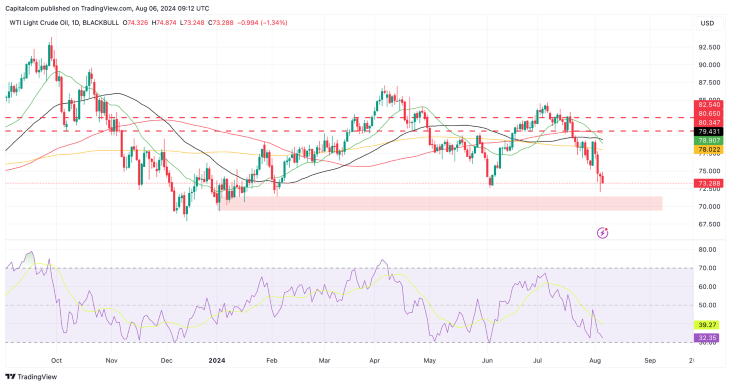
US Crude drops to 6-month low as recession fears loom
The negative sentiment that has taken over the stock market has spilled over into other asset classes too. Commodities have seen increased volatility in recent days as traders react to fears of a possible US recession, following weaker-than-expected jobs data last Friday. Oil, which is highly sensitive to the economic cycle, has seen a sharp downturn in recent weeks, driven mostly by softer US data, starting with the weaker-than-expected US June CPI reading which was released early in July.
US crude (WTI) pulled back to a 6-month low on Monday as fear took over in markets, with the Japanese Nikkei experiencing the worst performance in 40 years. But as tends to happen when sentiment takes over, we saw some overreaction in the moves which led to a correction later in the session, supported by stronger ISM non-manufacturing data which helped to calm some of the nerves. That said, the short-term bias remains to the downside with further weakness expected this week.
The prospects of a US recession have weighed on future demand expectations fuelling selling appetite. Traders should also be aware that the ongoing geopolitical risks in the Middle East provide a bullish driver for oil prices, but for now the concerns about demand outweigh the possibility of supply disruption.
On the chart, WTI is facing continued downside pressure on Tuesday despite the attempted recovery from the lows on Monday afternoon. The price has firmly set below its key moving averages, which now provide some resistance on the topside if a reversal were to happen. $79.34 is the key level to break for buyers attempting to change the momentum. In the meantime, a drop below Monday’s low at $72.03 could serve as validation for a continuation in the bearish pattern towards the $72, at which point some support may creep in.
US Crude (WTI) daily chart

Past performance is not a reliable indicator of future results.
With regards to what could be driving momentum this week, there is a lack of impactful economic events on the calendar so it will likely be down to sentiment. Further commentary from central bankers could drive some of the momentum, especially if there is further talk about and out-of-cycle cut this week, even if it seems highly unlikely.
One thing to keep an eye out over the coming weeks is OPEC+ and how it reacts to the recent moves. The plan was to start increasing production in October, though the group did indicate last week that this decision “could be paused or reversed, depending on prevailing market conditions.” It may be the case that the recent drop on prices won’t allow the cartel to reintroduce higher production as it could tank prices even further. If we were to see the decision to increase production pushed back to a later date, we could see a respite for oil prices.
Will OPEC+ react?
By Daniela Sabin Hathorn, senior market analyst at Capital.com

